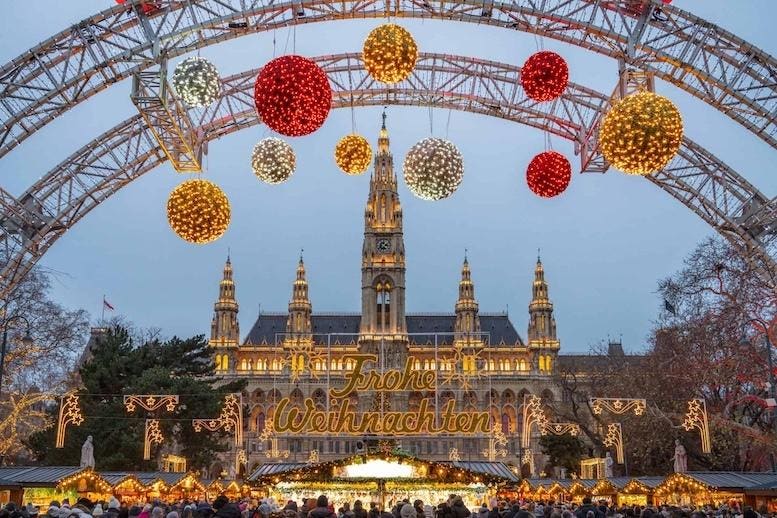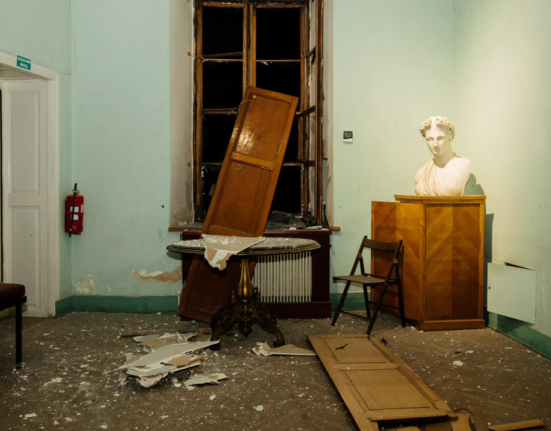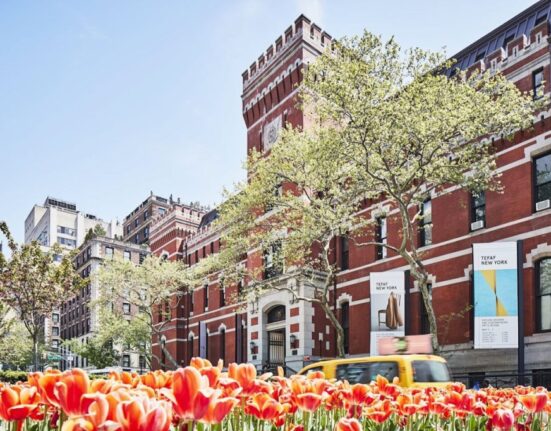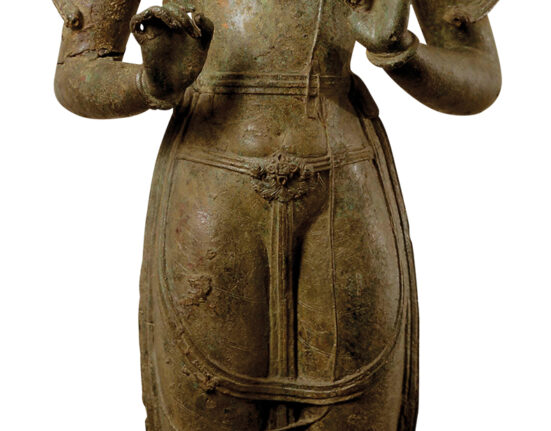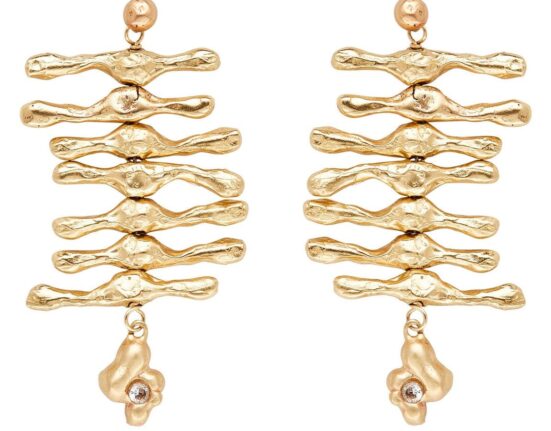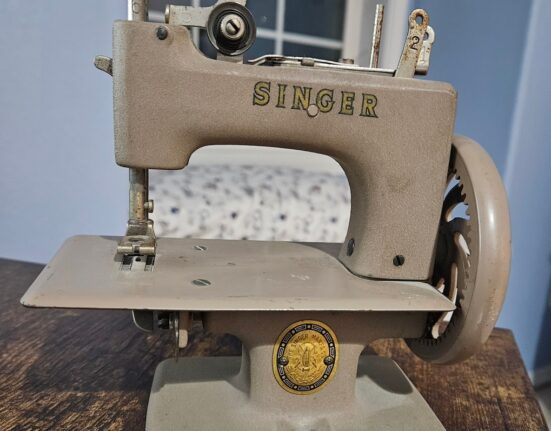The holidays add to Vienna’s already festive atmosphere year round.
Any time of year is a good one to visit Austria’s capital Vienna, for even though summers and early autumn are warmer than they used to be, the city has never experienced the 100-degree temperatures now routinely visited upon other European cities. In winter, its holiday and winter festivals are legendary for their color and enticements, and the city is so rife with trees and gardens that spring time is pure joy. With only about 5 million visitors each year, Vienna is never overrun like Paris, Madrid, and Rome. You need not wait on a long line to get into any of the major museums.
Plan for the Ringstrasse by Friedrich August von Stache. Preisgekrönte Entwürfe zur Erweiterung der … [+]
Justifiably, the city center has been a UNESCO World Heritage Site since 2001. Vienna’s architecture—Gothic, Baroque, Imperial, Art Nouveau, Secessionist—is some of the most striking in Europe. The location of the major arts and municipal institutions within and near the Ringstrasse that circles the city makes walking a leisurely joy, and 27 carefully situated cafés along the Ring’s route provide added incentive to take your time, enjoy some coffee and pastry.
The Albertina Museum is currently exhibiting a once-in-a-lifetime show of Michelangelo’s drawings … [+]
Right now, the Albertina Museum is exhibiting one of the most extraordinary shows of the century, “Michelangelo and Beyond” that deals with the emergence, significance and decline of the depiction of the human nude. The show manifests Michelangelo’s unmatched mastery of the human form in his drawings and studies for paintings, and how his influence was crucial to the art of Raphael, Dürer, Rembrandt, Rubens, Klimt and Schiele’s own work with the subject of the nude. (The show runs till January 14.) The Albertina has also published a splendid volume to accompany the show.
Bitzinger is a beloved wurst stand next to the Albertina museum
Afterwards, just steps away, another Viennese institution, the Würstelstand Bitzinger (Augustinergasse 1) dishes out two dozen variations of sausages including bosna,bratwurst, spicy currywurst and hot dogs (all from €5 to €6.80) with French fries (€3.20) and a long list of Austrian beers.
The stand’s location is at the Big Bus stop, which offers two “Hop-on Hop-Off” tours (from €32.17, valid for 24 or 48 hours) of about 110 minutes’ duration: The Red Line takes you around the city center’s best sites and the Danube; the Blue Line, which I do not recommend, spends about 40 minutes just getting out of town to drive past Schönbrunn Palace and the Belvedere Museum (both well worth visiting on their own).
The Vienna City Card for one, two or three days has free access to the city’s transportation, some … [+]
What makes Vienna especially appealing for those who speak no German is that all the Viennese seem fluent in English. And if you tire of walking, the tram and subway are easily mastered and very efficient. Purchasing a Vienna City Card makes everything extremely easy (€17 for 24 hours, €25 for 48 and €29 for 72), whose benefits include transport discounts in museums and tourist attractions for up to seven days; 20% discount on the daily room rate in participating hotels, and 20% discount in restaurants.
Located right nearby thew Albertina and Opera, the Amauris hotel is located in a nobleman’s building … [+]
As noted, Vienna is very easy to walk around at your leisure, stopping at three or four major attractions in a day, like the Hofburg Imperial Palace and the Rathaus Town Hall, not to miss the vast and very beautiful Kunsthistorisches Museum, whose walls contain dozens of the world’s greatest masterpieces, and the impeccably installed Naturhistorisches Museum. The Leopold Museum holds a comprehensive collection of the works of eccentric painter Egon Schiele; The Silberkammer is devoted to silverware; The Third Man Museum to the classic 1949 movie.
The very center of the city, anchored by the gorgeous Opera House, finished in 1869 as the first building on the Ringstrasse, is the beginning of one’s walking tour.
The Glasswng restaurant at the Amauris Hotel serves modern takes on tradition European cuisine.
My wife and I stayed nearby at the Amauris Hotel, converted as such in 2023 from a noble residence where the aristocracy met until the end of the monarchy. Today the Amauris (named after a Monarch butterfly) is an exquisite mating of the old and new, with art by exceptional 19th and 20th century Austrian painters, lighting by the Italian design company FLOS, 160 tons of Italian marble and an historic elevator cage in cast iron.
The Amauris is a large building but still has the feeling of a boutique hotel, and its rooms are exceptionally spacious, the most impressive being the two-story, 60 square meter (nearly 650 square feet) Maisonette Suite located just under the skylight roof.
The elegantly appointed and very chic Glasswing Restaurant is done in tones of white, black and gray, with Executive Chef Alexandru Simon serving a blend of Austrian tradition and fusionary modernism both a la carte and as a 7-course menu at €160.
St Stephen’s Cathedral is close to its total restoration is one of Europe’s finest examples of … [+]
We headed for the Kärntner Strasse, a broad and winding commercial avenue lined with designer boutiques, cafés, chocolate shops, restaurants, and street performers, to find the 12th century St. Stephen’s Gothic Cathedral—saved from deliberate destruction in World War II because a German captain refused his superior’s orders to reduce it to rubble—now almost fully restored since my last visit, and now as glorious as any similar cathedral in Europe. Composer Antonio Vivaldi is buried in the cemetery next door. Nearby you may stop for Aida pastries and what is advertised as the world’s best ice cream at the Café Konditorei. (It really is terrific.)
Roasted lentils are part of the largely vegetable menu at Wrenkh
Before devoting our afternoon to more strolling, we sought out a light lunch at Wrenkh (Bauernmarkt 10), which is not strictly vegetarian but is very devoted to seasonal produce on a menu that included Austrian mountain lentils and roasted dumpling in white wine sauce (€12.5); a Wrenkh salad with rapeseed dressing, crispy polenta; smoked tofu and Parmesan (€15.5); a mushroom schnitzel with potato salad and sauce ravigote (€18.5), and a salmon trout filet in tomato butter with artichokes and potatoes (€28.5). The wine list is not long but has several fine Austrian bottlings and by the glass.
Das Loft is one the 18th story of the SO Vienna hotel and has both a tour cocktail lounge and a fine … [+]
That evening we dined at Das Loft atop the 18th floor of the SO Vienna Hotel (Praterstrasse 1) with a fabulous panorama of the city. The lighted kaleidoscope-like ceiling alone is reason enough to go to the cocktail lounge here (drinks run €16 to €18), but, despite booming techno music that makes conversation difficult—the only restaurant in Vienna where I found this to be so—I highly recommend the modern cuisine here and one of the finest wine lists in the city. There is a tasting menu at €130 for four courses, as well as à la carte items. My wife and I thoroughly enjoyed a meal of tomato with a blue cheese mousse with basil emulsion (€22); sweetbreads dumpling with parsnips and truffles (€22) as appetizers; braised veal cheeks in a celeriac, bacon and Madeira sauce (€39); and very succulent Styrian chicken with cabbage, Jerusalem artichokes and tangy lemon sauce (€39), ending with lovely, inventive desserts of salted stracciatella with pistachio, rose and cherry (€24), and a selection of Alpine Vorarlberger cheese made by Anton Macht (€26), both desserts enough to share for two.
A few words about dining out in Vienna:
* Just about every restaurant has a menu in English.
* Dress, as everywhere in Europe these days, is casual, but at the more traditional restaurants and cafés you will want to dress a bit conservatively, although blue jeans are everywhere.
* There is no smoking allowed inside.
* Service is unfailingly courteous, and in the cafés very efficient.
* As for tipping, VAT tax and service are already included in the meal’s price, and many list a cover charge. But tipping is not requisite, and leaving more than ten percent, if you wish, is generous.

